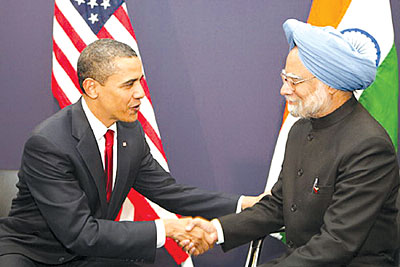 |
NEW DELHI âï��" Barack Obama, the sixth American president to visit India since it gained independence, arrives at a trying time, both for the United States and for India. Some of Obama's closest advisers have just resigned, opening an awkward gap on national security and the economy âï��" the focus of his meetings with India's government.
For India, the issues on the agenda for Obama's visit are immense and complex, and the options for resolving them are extremely limited. Those related to security in Afghanistan and Pakistan are as treacherous as they have ever been. Bilateral economic, trade, and currency disagreements may not be as bitter as they are between the US and China, but they are thorny, and lack of resolution is making them more intractable.
Nuclear non-proliferation remains one of Obama's priorities, as does the sale of US civilian nuclear technology to India, for which former President George W. Bush cleared the way. And Obama will be keen to know what help India can provide with Iran, a country with which India has smooth relations, owing to their shared worries over Afghanistan and Pakistan.
Given this potent list of challenges, what are the prospects for Obama's passage to India? Some years ago, I was queried by then US Deputy Secretary of State Strobe Talbott, who was helping to prepare President Bill Clinton's visit. As India's foreign minister at the time, I told him: "Why make the visit destinational? Be content with the directional," or some such words. That response retains its flavour today: as new directions in India-US relations are set, new destinations will follow.
All state visits are overloaded with lofty, superfluous rhetoric. US-India summits are particularly prone to this hubris: the Great Republic meets the World's Largest Democracy. It would be better for both countries to shed some of these marigold garlands of cloying adjectives.
Another feature of such summits âï��" the trading of lists of 'must do' and 'can do' items âï��" also should be retired. It is both demeaning and tedious to treat an arriving US president as a stars-and-stripes Santa Claus, to be presented with lengthy wish lists. Likewise, despite America's pinched economic circumstances, Obama would do well not to use his visit to peddle US wares. Although trade is an effective lubricant of good relations, these sorts of talks are for the 'sherpas', not Obama and Prime Minister Manmohan Singh, to handle.
These two great countries, 'natural allies' in the words of former Prime Minister Atal Bihari Vajpayee, should reflect on what they have accomplished together since 1998, in order to map what lies ahead. Theirs is now a relationship of equals, so their national interests need to be reconciled on everything from Pakistan to climate change.
Indeed, Obama is placed in a unique position for an American president, a position that he appears to comprehend, though his opponents in the US do not. Power today begins in the acceptance of the limits upon it. This is also true of an India that is only now coming to recognise its new status in the world, in which the country's limits and responsibilities have expanded mightily.
Ours is an unstable neighbourhood, one that America has entered without fully understanding the consequences âï��" for India and for the neighbourhood. India must ask Obama hard questions about how security is to be assured, but, before doing so, it needs to ask the same questions of itself.
India must make clear âï��" and the US must recognise âï��" that a subcontinental country of a billion-plus people cannot be kept within the categorical confines of 'South Asia'. The US must accept and candidly discuss the damaging consequences of its military, diplomatic, and political overreach âï��" of a 'war too far' that has brought the region to its current ugly impasse.
What can the two countries do, separately and together? Both leaders must accept that history is destiny, and that the irrefutable logic of geography is a determinant of it. This is the only relevant and reliable guide in meeting the region's complex challenges.
The constraints on US options, the veto of circumstances, offers little room for diplomatic improvisation. Here the greatest constraint is America's difficult and worsening relationship with Pakistan. India must understand this troubled partnership, into which America entered with its eyes wide open, though it would help if the US accepted that India has paid âï��" and continues to pay âï��" a very high price on this account. Only through such acceptance can the two countries chart a common future.
Likewise, it would be unwise for the US gratuitously to offer China a role in the affairs of a region that includes India itself âï��" something that Obama appeared to do during his visit to China earlier this year, when he mentioned China as having a role to play in Kashmir. The US should also stop questioning India's relationship with Iran, a neighbour with which India is linked by many centuries of economic, cultural, and even civilisational ties.
Two great peoples and countries, although now locked in a 'strategic alliance', may occasionally fall out of step with one another, as India and the US have âï��" for example, over global climate negotiations. But, at such moments, Obama might do well to recall Vajpayee's words during Clinton's visit, when he quoted Walt Whitman's poem 'Passage to India':
"Sail forth âï��" steer for the deep waters only,
Reckless O soul, exploring, I with thee, and thou with me,
For we are bound where mariner has not yet dared to go."
Jaswant Singh, a former foreign minister, finance minister, and defense minister of India, is a member of the opposition in India's parliament.Âï��
www.project-syndicate.org


